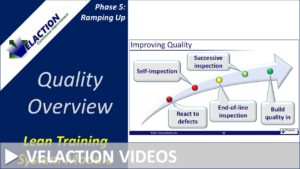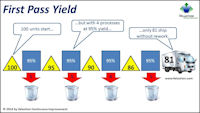First Pass Yield
First pass yield (FPY) is a metric that indicates the percentage of items moving through a series of processes without any problems.
The basic equation for first pass yield is:
First Pass Yield = Process 1 Yield * Process 2 Yield *…*Process ‘n’ Yield
As you can see, the more process steps you have, the more challenging it will be to get an item through the system without any issues. For example, consider an operation that has 4 processes, each with a yield of 95%.
Using the first pass yield equation above, the FYP is:
.95 x .95 x .95 x .95 = .81
That means that even with 4 processes performing at a 95% yield, one out of every 5 products will not make it through your system without needing rework.
 Watch Our Closely Related Quality Overview Video
Watch Our Closely Related Quality Overview Video

As you can infer from the equation, the effectiveness of a process plays a big role in determining first pass yield. But the total number of processes also has a huge impact. One of the areas where Lean really shines is in simplification. Reduce the number of processes that it takes to produce a product, and you also reduce the number of chances to make a mistake.
It is also worth noting that looking at quality numbers for individual processes can be misleading from a system perspective. As you can see from the example above, it doesn’t take long for defect rates to stack up. With four processes having a 95% yield, good products only come off the line without any rework 81% of the time. Even with a 97% or 98% yield for individual processes, the rolled through yield can be dramatically lower for the entire system.
Rework and First Pass Yield
Most processes have hidden factories built in. There are corrective actions a person takes when they see a problem. This rework is almost never included on work instructions, and seldom shows up in any form of quality log. For that reason, first pass yield is often underestimated.
If you really want to improve quality, you must find a way to track this sort of activity. Be clear that it is not intended to be punitive. People will protect each other if they think that punishment results from tracking data. The goal should be to improve processes, not catch violators.
Units vs. Total Defects
Note that this metric is used on a unit basis. An item is considered a fail whether it has one or multiple defects. Other metrics (i.e. DPMO, or defects per million opportunities) can be a better judge of quality when products have numerous issues or a significant number of process steps.
Rolled Through Yield vs. First Pass Yield
Some terminology comes from disciplines that have a definitive organization that dictates what its terms mean. Accounting, for example, is governed by a handful of organizations (i.e. the IRS, GAAP, etc.) that specifically define the meaning of many terms.
Other disciplines, however, do not have a single organization that governs the usage of its terminology. That means that terms can mean different things to different people, or different terms can be used to describe the same thing.
With regards to first pass yield, there is no single governing body for quality or Lean. There are some major players like ISO, but they don’t have the same sort of authority as the governmental agencies listed above.
For that reason, you will likely see some differences in how this metric is named. While we call it first pass yield, you may also see it referred to as first time yield. And it may also be called rolled through yield or rolled throughput yield.
It is also worth noting that a quick internet search will yield some variation in the meaning of the terms. While we recommend using the term first pass yield with the calculation described above, if you choose something else, be sure it is clearly understood throughout your company.

First Pass Yield Words of Warning
- Be careful about rework. Often items are fixed within a process and don’t show up as a defect. Other times, work is repaired offline and then added back into the system. Make sure that the measurement system you use to track first pass yield clearly defines how to handle these issues.
- One of the challenges in understanding first pass yield is the lack of visibility. Because most frontline workers want to do a good job, they fix problems on the spot, or help out their upstream As a result, defects are not recorded, making the first pass yield rate look better than it really is.



0 Comments